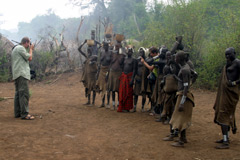Tourism

Mursi line up to be photographed by a tourist in the Mago Valley. (Ben Dome, 2004)
Foreign tourists are attracted to the Lower Omo by the image presented to them in travel agents’ brochures and newspaper articles of one of the last ‘wildernesses’ in the world, inhabited by wild animals, naked warriors and – in the case of the Mursi – by women wearing large pottery discs, or plates, in their lower lips. Here is an example of this literature, from an article by Amanda Jones that appeared in the Sunday Times Travel Section, 21 November 1999, under the heading ‘Tribes and tribulations’.
The final leg of our journey was to the Mursi people. In southern Ethiopia, this is the tribe who strike fear into the hearts of northern Ethiopians and tourists alike. We’d heard so many lamentable tales about their behaviour, that we didn’t really know what to expect. The problem is that you can’t possibly come all this way and miss the Mursi, famous for the lip plates the women wear in their lower lips.
Because of their reputation, most visitors make a six-hour round trip drive from Mago National Park to see them. They come tearing down the road, jump out of their cars with cameras blazing and Birr aflying, create a riot, get scared, jump back into the car, lock the doors and take off again after 15 minutes. The Mursi have this down to a fine art. They encircle the ferengie, manhandle them a little, exact inflated sums for photos, force them to buy chipped lip plates and then whip up such a racket that the tourists retreat with only a few terrible snap shots of lip plates looming inches from their lens to show for their expensive foray into Mursi land.
In this tourist literature, the lip-plate symbolizes the ‘tribal’ and ‘untouched’ world of the Mursi, which should not be missed by anyone venturing into the Omo Valley. But it is their growing integration into the economic life of the highlands which drives Mursi of both sexes to play the demeaning part of archetypal primitives, as they line up to be photographed by passing tourists in exchange for the equivalent of a few pence.
The exaggerated body painting and body adornments (e.g. the wearing of cattle headdresses or women carrying guns) is an example of cultural distortions introduced in order to compete for revenue from tourists. Tourists are often surprised when they learn that this is not the daily appearance of the Mursi. In fact, tourism has drastically altered how the Mursi treat outsiders. The aggressive behaviour seen in places where Mursi meet tourists is very rarely found elsewhere in Mursiland. The encounter with tourists is based purely on a brief financial exchange, not on the development of a relationship and the cash that it generates often leads to drunkenness. The resort to alcohol is partly due to the Mursi feeling increasingly peripheralised and objectified in their own home.
More information
Jon Abbink, 'Tourism and its discontents: Suri-tourist encounters in southern Ethiopia'. In S. Bohn Gmelch (ed.), Tourists and tourism: a reader. Second Edition, 2009, pp. 115-136. Long Grove, Ill.: Waveland Press, Inc.
David Turton, ‘Lip-plates and “the people who take photographs”: uneasy encounters between Mursi and tourists in southern Ethiopia’, Anthropology Today. 20 (3), 2004, pp. 3-8.
See also the following film-clips:
- Trailer for the film ‘Framing the other’ (2011), YouTube

